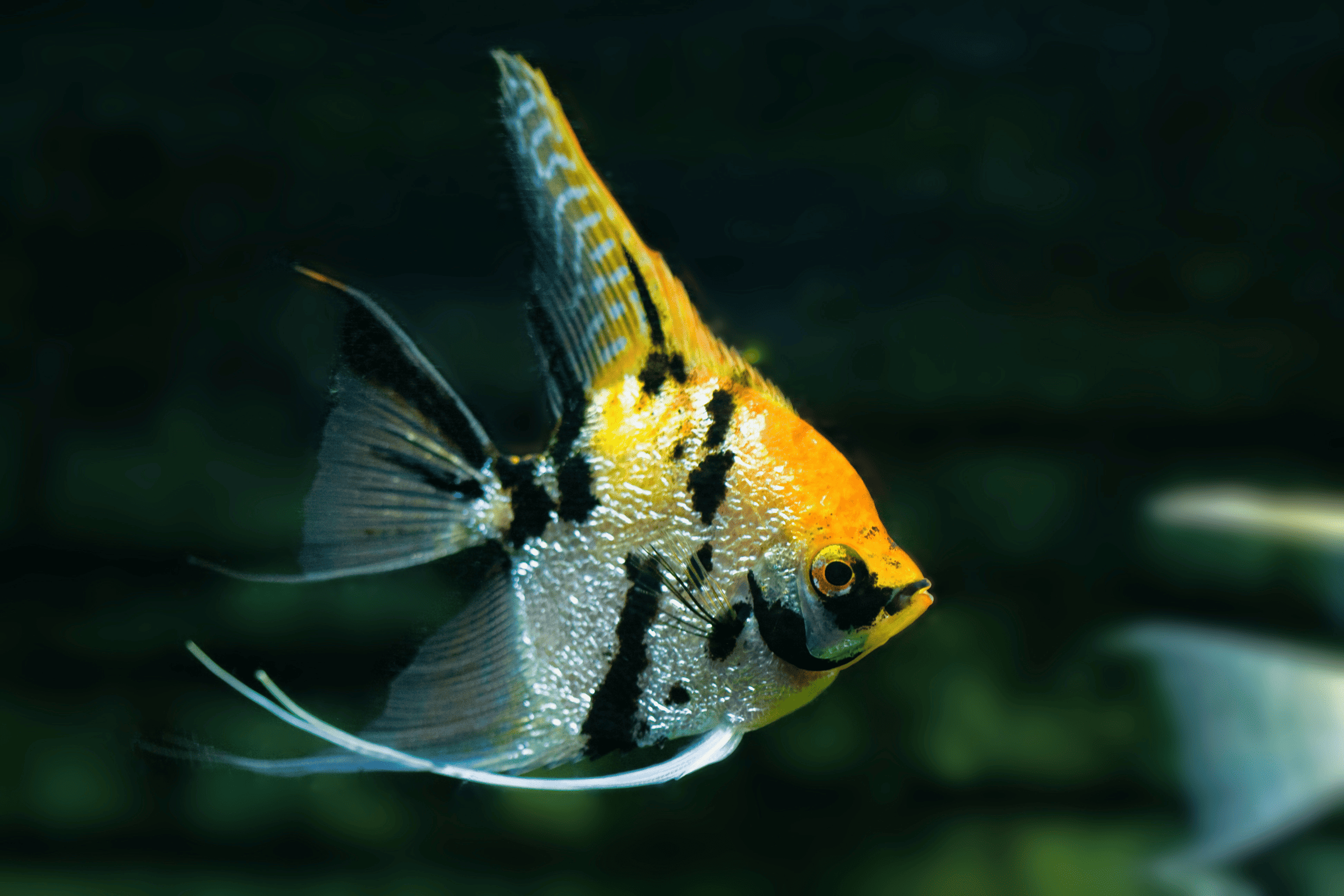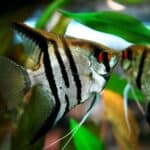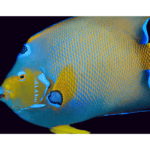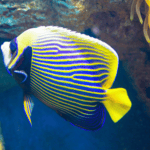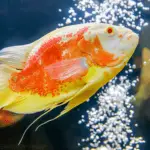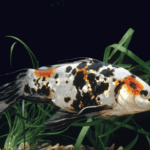Angelfish are a popular choice for aquarium enthusiasts, admired for their unique appearance and graceful movements. These beautiful fish are known for their long, elegant fins and vibrant colors, making them a captivating addition to any home aquarium. As captivating as these creatures are, potential aquarists often wonder about their lifespan in captivity, an essential factor to consider when deciding to bring them into your aquatic family.
On average, angelfish tend to live for 10-12 years in a well-maintained tank, with some even reaching up to 15 years in exceptional conditions. Their longevity is heavily influenced by factors such as tank size, water conditions, and diet. As hardy fish, they can be raised by beginners, making them an appealing choice for those just entering the world of aquarists.
To ensure a long and healthy life for your angelfish, it is crucial to provide them with an environment that closely mimics their natural habitat. This includes warm, slightly acidic water, a fine substrate, ample plants, and adequate sunlight. Having a proper understanding of their care requirements and offering a suitable living environment will help maximize their lifespan and ensure the well-being of your angelfish.
Angelfish Basics
Species
Angelfish belong to the Pterophyllum genus and are a popular type of tropical fish found in many aquariums. There are three primary species of angelfish: P. scalare, P. altum, and P. leopoldi. Each species has its distinct characteristics and behaviors, but they all share similarities in their appearance and basic care requirements.
Size
Angelfish can vary in size depending on the species, with most freshwater angelfish reaching a body size of 6-8 inches in length and a height of 8-10 inches including the fins. In comparison, saltwater angelfish can grow up to 18 inches in length, making them suitable only for larger marine aquariums.
Colors
Freshwater angelfish come in a variety of colors and patterns, including:
- Silver: the most common color, silver angelfish have a silver body with black vertical stripes
- Koi: featuring a mix of red, white, and black patches, resembling the colors of koi fish
- Zebra: similar to the silver angelfish but with more prominent black stripes
- Leopard: characterized by a body covered with black spots, resembling a leopard’s coat
Saltwater angelfish also display a range of vibrant colors, with each species having its unique patterns.
Genetics
The various colors and patterns of angelfish are a result of both natural and selective breeding. Genetic factors play a significant role in determining an angelfish’s color and pattern. Some traits are dominant, while others are recessive, and breeding different types of angelfish can result in offspring with a wide range of appearances.
Understanding the genetics of angelfish can be valuable for enthusiasts looking to breed specific colors or patterns, and it plays a key role in maintaining the health and diversity of aquarium populations.
Angelfish Lifespan
Factors Affecting Lifespan
Several factors influence the lifespan of angelfish, including:
- Tank size: A spacious tank allows for better movement and overall fish health.
- Water conditions: Maintaining the proper pH, temperature, and water cleanliness is essential for angelfish well-being.
- Diet: Feeding your angelfish a balanced diet rich in necessary nutrients helps ensure they stay healthy and live longer.
- Stress: Reducing stress by providing hiding places and limiting external disturbances contributes to angelfish longevity.
Average Lifespan for Different Species
There are various species of angelfish, and their average lifespans differ based on their type and living conditions:
- Freshwater angelfish (Pterophyllum scalare): 10-12 years
- Coral beauty angelfish (Centropyge bispinosa): Up to 15 years in nature; 10-15 years in captivity
Remember to provide a clean, well-maintained aquarium, a balanced diet, and stable water conditions for your angelfish. These conditions significantly contribute to their overall health and support their maximum lifespan potential.
Creating an Ideal Home for Angelfish
Aquarium Preferences
Angelfish thrive in a well-maintained aquarium with the right water parameters and decorations. By setting up an appropriate environment, you can ensure the health and longevity of your angelfish. Here are some essential factors to consider when creating a suitable home for your angelfish:
Water Parameters
To maintain the health of your angelfish, it’s vital to monitor the water parameters in their tank. These fish can tolerate a relatively wide range of pH levels, but they prefer slightly acidic, soft water. The ideal water parameters are as follows:
- Temperature: 76-82°F
- pH: 6.5 – 7.5
- Water hardness: Soft to moderately hard
Tank Size
Angelfish are moderately large fish, and they require ample space to swim and grow. A minimum tank size of 20 gallons is recommended for a pair of angelfish, adding an extra 10 gallons for each additional fish.
Plants and Substrate
Live plants not only contribute to a visually appealing aquarium but also provide essential hiding spots and improve water quality for your angelfish. Some excellent plant options include:
- Java fern
- Amazon sword
- Anubias
For substrate, choose a fine-grained option like sand or fine gravel, which allows for easy cleaning and promotes a natural environment for your fish.
Hiding Places
Providing hiding places in the aquarium is essential for the well-being of your angelfish. You can use driftwood, rocks, or decorations to create natural hideouts that offer a sense of security for your fish.
Cleaning and Maintenance
Regular maintenance is crucial for maintaining a healthy environment for your angelfish. Here’s a brief maintenance checklist:
- Perform partial water changes (25-30%) every two weeks or when the water becomes cloudy.
- Clean the substrate and surfaces of decorations using an aquarium brush.
- Check water parameters consistently to ensure stability.
By following these guidelines, you can create an ideal home for your angelfish to keep them happy and healthy throughout their lives.
Related: Emperor Angelfish: Fascinating Facts and Expert Care Tips
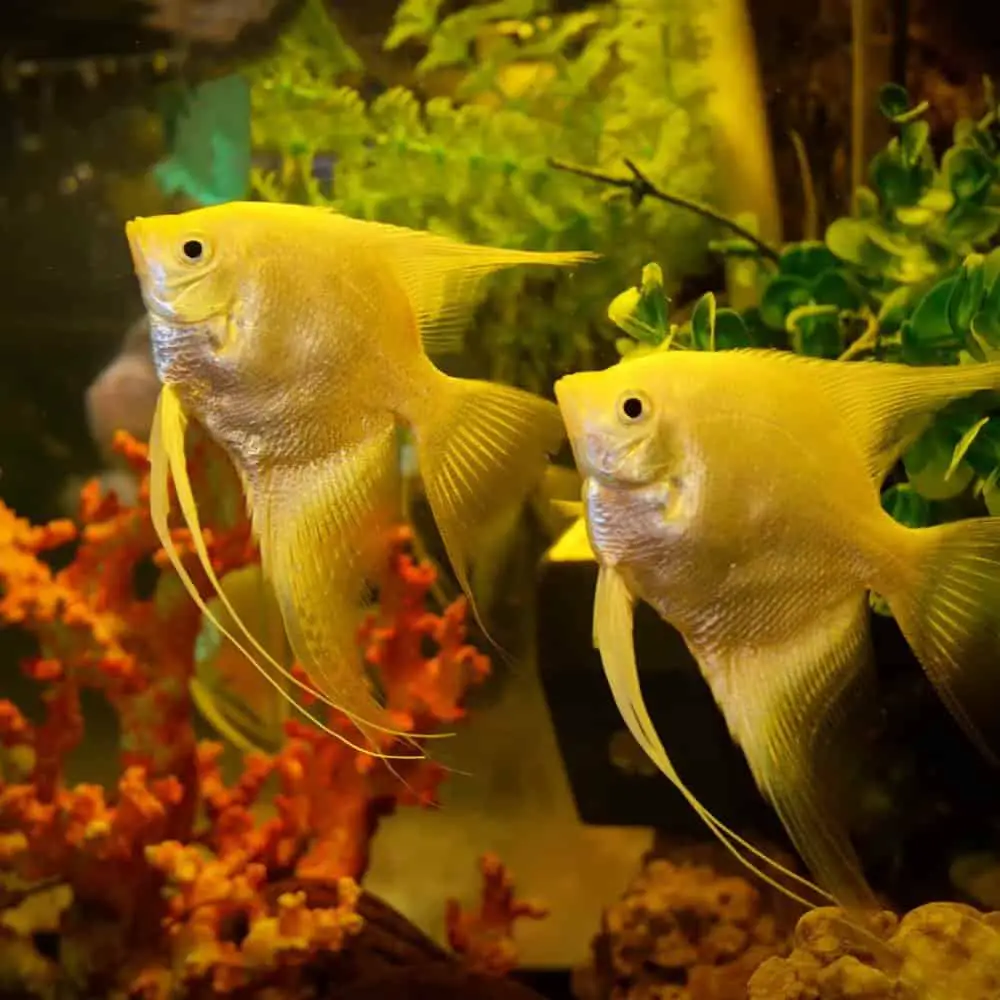
Angelfish Diet
Feeding Preferences
Angelfish are omnivores and have diverse feeding preferences in their natural habitat. They feed on a variety of food sources, such as insects, small fish, crustaceans, larvae, and plant matter. In order to keep angelfish healthy in captivity, it is essential to mimic their natural diet and provide them with a well-balanced mixture of live, frozen, and pellet foods, as well as vegetables.
Live, Frozen, and Pellet Food Options
Angelfish enjoy a diet that includes live food, frozen food, and pellets:
- Live food: Providing live food, such as brine shrimp, daphnia, and bloodworms, can imitate an angelfish’s natural hunting instincts and offers excellent nutritional value. However, live food should be offered as a treat rather than a staple diet as it can introduce parasites and diseases into the aquarium.
- Frozen food: Frozen options like bloodworms, brine shrimp, and daphnia are more easily available and pose less risk of introducing diseases to the tank. Defrost frozen food before feeding your angelfish, and remember to remove any uneaten food after a reasonable time to maintain water quality.
- Pellets: Angelfish pellets can offer a well-rounded diet with essential vitamins and minerals. Look for high-quality pellets specifically designed for angelfish and incorporate them into their daily feedings.
Vegetables
As omnivores, angelfish also benefit from the inclusion of vegetables in their diet. Vegetables can provide essential nutrients and vitamins, helping to maintain optimal health. Some suitable vegetables for angelfish include:
- Blanched spinach: Spinach is packed with vitamins and minerals, making it a great addition to your angelfish’s diet. Blanch the spinach in boiling water for about 30 seconds, and then rinse under cold water before feeding.
- Squash and zucchini: Thinly sliced or grated squash and zucchini can be added directly to the tank. These vegetables are rich in nutrients and can help support the immune system of your angelfish.
- Peas: Shelled and crushed peas can be fed to angelfish in small quantities as an occasional treat. Peas provide essential fiber, which can help maintain a healthy digestive system.
Remember that providing a diverse diet is crucial for the long-term health and well-being of your angelfish. Monitoring your angelfish’s diet can help prevent overfeeding and maintain a stable environment in your tank, contributing to a longer lifespan of 10-12 years in captivity.
Angelfish Care
Health and Disease Prevention
Maintaining angelfish health starts with providing a clean and stable environment to reduce stress. Stress can make your angelfish more susceptible to diseases. To keep your angelfish healthy, follow these guidelines:
- Feed them a high-quality and varied diet with a mix of flakes, pellets, and occasional live or frozen foods.
- Regularly monitor water conditions, temperature, and pH levels to ensure they stay within the recommended range for freshwater angelfish.
- Perform routine water changes to maintain optimal water quality.
Water Management
Proper water management plays a vital role in angelfish care. Freshwater angelfish thrive in these water conditions:
- Temperature: 75-82°F (24-28°C)
- pH Level: 6.5-7.5
- Water hardness: 3-8 dGH
Implement regular water changes, at least 25% of the tank’s volume every 2 weeks, to maintain these parameters.
Social Aspects: Tank Mates and Territorial Behaviors
Angelfish are cichlids, which can display territorial and aggressive behaviors. When considering tank mates, opt for non-aggressive and similarly-sized fish. Suitable tank mates for angelfish include:
- Cory catfish
- Larger tetras
- Discus
- Dwarf cichlids
- Loaches
- Plecos
However, avoid keeping angelfish with betta fish, smaller tetras, or guppies since they might see them as food.
Angelfish prefer a well-decorated tank with hiding spots, like plants, caves, and driftwood, which can help keep territorial behaviors in check. To ensure every angelfish has its own territory, provide ample hiding spaces, and consider adding taller tank decorations. Additionally, try to keep your angelfish in groups of 5 or more as this will diffuse aggression among the group.
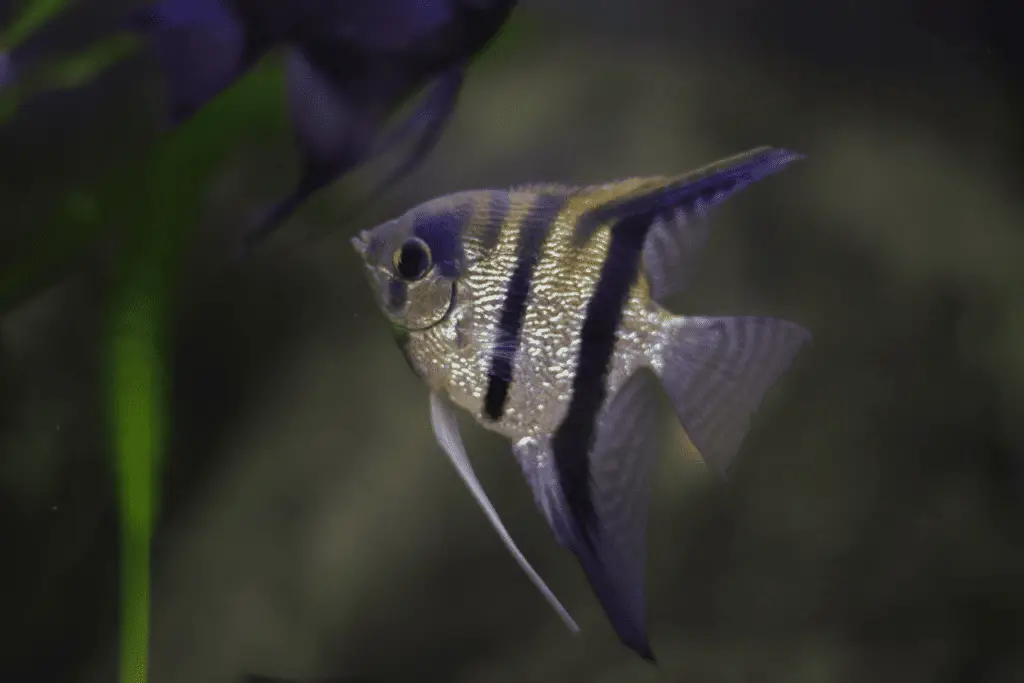
Breeding Angelfish
Selecting a Breeder Pair
When breeding angelfish, it’s important to choose a healthy, compatible breeder pair. They should be mature and active, showing signs of readiness to breed. Remember that angelfish come in various colors such as marble, platinum, and gold, so pick your preferred pairing. They belong to the cichlid family and are scientifically known as Pterophyllum scalare, native to the Amazon River Basin.
Breeding Spaces
Angelfish require a spacious and comfortable environment for successful breeding. Set up a freshwater aquarium that is at least 20 gallons (75.7 L) and preferably 29 gallons (110 L) large. Decorate the tank with plenty of plants and cured driftwood for hiding spots. A bare bottom tank works best for breeding, but you can paint the exterior bottom of the tank with a dark matte color to minimize reflections and make the fish feel more at ease.
Egg and Fry Care
Angelfish pairs lay eggs which then require careful monitoring and care. Maintaining water quality and temperature is vital for the survival of the eggs and eventual growth of the fry. Extra attention should be given to feeding both the angelfish pair and their offspring during this time. After the eggs hatch, the fry will need suitable food, such as baby brine shrimp or specially formulated fry food.
Sex Differences
Identifying sex differences in angelfish can be challenging, especially for inexperienced breeders. However, male angelfish tend to have a more prominent nuchal hump on their head, while female angelfish usually have a rounder, more swollen belly when carrying eggs. Understanding these differences will help you select the right breeding pairs.
Breeding Season and Strategies
Angelfish do not have a specific breeding season in captivity, but it helps to maintain stable water conditions and follow best practices to encourage breeding. Ensure proper tank setups, diet, and care for your angelfish pair to promote a successful breeding process.
Remember to educate yourself further on angelfish breeding techniques and consult experienced breeders if necessary to ensure the health and well-being of your angelfish throughout the breeding process.
Angelfish Physiology and Environment
Temperature and Water Conditions
Angelfish are native to South America and reside in freshwater environments within the Amazon River system. They thrive in warm water, with temperatures between 76°F to 84°F (24°C to 29°C). Maintaining these temperatures and ensuring stable water conditions are essential for their overall health.
- pH levels: Angelfish require a pH level of 6.0 to 7.5 for optimal health.
- Water hardness: These fish prefer soft water with a hardness range of 3 to 8 dGH.
The Amazon River and Its Influence
The Amazon River has a significant influence on the angelfish’s natural habitat. This vast river system contains a variety of ecological niches, including floodplains, swamps, and slow-moving water bodies. Dense vegetation in these areas offers them an ideal environment for hunting prey and evading predators. The river’s water quality varies from clear to silty, affecting the appearance and physiology of angelfish living in different regions.
Toxins and their Effects
Exposure to toxins can have adverse effects on the angelfish’s overall health and lifespan. It is crucial to maintain a clean and toxin-free environment in both their natural habitat and aquarium setups. Some factors to consider include:
- Avoiding the use of harmful chemicals and medications that can lead to toxin build-up.
- Regularly monitoring water quality to detect harmful substances.
- Implementing proper filtration systems to eliminate pollutants and maintain optimal water parameters.
By considering these factors, angelfish can live a healthy life, reaching their typical lifespan of 8 to 15 years in captivity. In their natural environment, survival rates may vary due to factors like predation, water quality changes, and habitat destruction.
Different Angelfish Varieties
Angelfish are popular freshwater pets in the aquarium hobby due to their elegance and the variety of colors and patterns available. In this section, we will explore some popular types of angelfish and their unique physical features.
Popular Angelfish Types
- Silver Angelfish: Silver angelfish are the classic variety, often displaying dark vertical stripes on their silver bodies.
- Zebra Angelfish: Zebra angelfish have bold, dark stripes running horizontally across their bodies, resembling the pattern of a zebra.
- Koi Angelfish: Koi angelfish have a mix of bright colors, including orange, black, and white, reminiscent of koi fish.
- Leopard Angelfish: Leopard angelfish have irregular black spots spread across their bodies, similar to a leopard’s coat.
Unique Physical Features
Angelfish are known for their triangular shape and long, flowing fins. They typically grow up to 4 to 8 inches long and can live up to 10-12 years in captivity with proper care.
Angelfish enjoy a well-planted tank with plenty of foliage to hide among. Providing aquatic plants like Anubias, Java Fern, and Amazon Sword not only enhances their habitat but also serves as a source of nutrition.
The beautiful patterns and colors of angelfish varieties come from selective breeding over many generations. However, it is essential to maintain a proper environment and diet for angelfish to thrive and display their vibrant hues.
In summary, silver, zebra, koi, and leopard angelfish are popular types sought after by aquarium enthusiasts due to their unique physical features and compatibility with aquatic plants.
